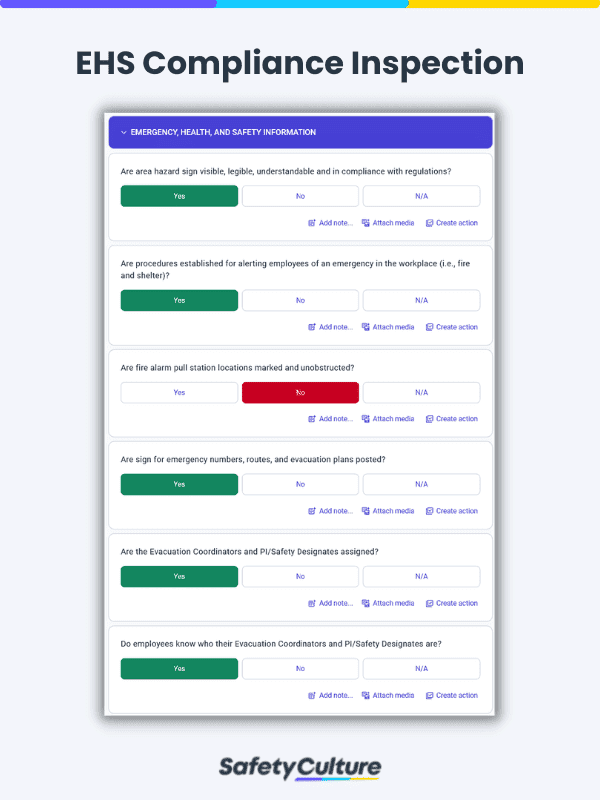What is EHS Compliance?
EHS Compliance is an industry regulation that refers to the rules, policies, programs, and protocols surrounding workplaces and aims to ensure that all company activities do not put the workers’ health and safety at risk, or cause any excessive environmental damage.
Sometimes referred to as HSE Compliance or EHSQ (for Quality), EHS (Environment, Health, and Safety) Compliance is also the combination of all actions, activities, prohibitions, and directives created to prevent workplace injuries or illnesses, contamination in the facility, and pollution in the environment.
Per Occupational Safety and Health Administration (OSHA), implementing safety processes also aims to improve compliance with rules, reduce costs, prevent penalties, engage workers, and increase overall business operations.
EHS is enforced by federal and international agencies such as OSHA, Environmental Protection Agency (EPA), and Nuclear Regulatory Commission (NRC), among others.
Consequences of Non-Compliance with EHS
EHS is a legal requirement for businesses and failing to comply doesn’t just result in financial penalties but can lead to various other hidden and long-term consequences. Below are just some of the negative impact of non-compliance to organizations and individuals:
- Injury and illness – One of the most common consequences of failure to comply with EHS. In 2020, the United States recorded a total of 4,764 fatal work injuries, and a significant percentage of this is caused by accidents in relation to safety.
- Fines/penalties – Incidents caused by non-compliance to safety can also result in fines and penalties depending on the type and severity of violation.
- Civil lawsuits/criminal charges – In extreme cases, these violations can result in either a civil lawsuit or criminal charge. This would also have financial implications and can put a strain on company assets and resources, so much so that it can cause changes to the way the company operates.
- Damaged employee relations – It is the company’s responsibility to ensure the safety of their employees and failure to comply with EHS protocols can often expose workers to dangers and risks. This can create a loss of trust which can lead to increased employee turnover.
- Tarnished reputation – Non-compliance can lead to media grilling, negative public opinion, and unwanted attention from pressure groups.
- Threats to the environment – One other primary purpose of EHS is to protect the environment and failure to comply with its protocols that focus on reducing negative environmental impact can lead to more environmental damages or threats.
Steps to be EHS Compliant
Regulations in different regions are constantly evolving and companies must proactively monitor these changes to avoid setbacks in their operations. It is also important to address and update internal policies according to said changes and in compliance to the requirements of the regulating bodies.
All these can be hard to keep up with so it’s essential to apply the basic steps in ensuring EHS compliance:
- Identify applicable regulations – Relevant policies vary depending on those that apply to the specific industry, as well as the governing body enclosing your organization such as federal, state, and municipal, and identifying which of these regulations apply to yours is important in properly complying with them.
- Understand relevant requirements – Identifying relevant operational requirements is important in accelerating the steps to EHS compliance.
- Monitor developments – As initially mentioned, regulations are constantly changing so companies must keep an eye on these developments and accordingly apply them to their operations.
- Determine points of change – Not all policies will be applicable to your operations so sorting through all of these and highlighting the relevant ones is a good starting point.
- Implement changes – Collaborate with team and subject matter experts in recognizing relevant changes. Integrate them to daily operations and procedures.
- Document compliance – Record a copy of compliance reviews for future audit needs and reference.
Improve your EHS Management
Cultivate a safe working environment and streamline compliance with our EHS solutions.
Explore nowGeneral EHS Guidelines
There’s no specific format to follow in monitoring environment, health, and safety issues in businesses as this depends on the industry as well as other factors. International Finance Corporation, however, released updated EHS recommendations that apply to all industries and can be used as a guide in implementing them.
Environmental – All the environmental factors that businesses need to be conscious of and constantly observe are the following:
- Air Emissions and Ambient Air Quality
- Energy Conservation
- Wastewater and Ambient Water Quality
- Water Conservation
- Hazardous Materials Management
- Waste Management
- Noise
- Contaminated Land
Occupational Health and Safety – All the health and safety hazards in relation to the actual operation, production, and facility that businesses need to check:
- General Facility Design and Operation
- Communication and Training
- Physical Hazards
- Chemical Hazards
- Biological Hazards
- Radiological Hazards
- Personal Protective Equipment (PPE)
- Special Hazard Environments
- Monitoring
Community Health and Safety – All the health and safety elements specific to community factors and responsibilities are:
- Water Quality and Availability
- Structural Safety of Project Infrastructure
- Life and Fire Safety (L&FS)
- Traffic Safety
- Transport of Hazardous Materials
- Disease Prevention
- Emergency Preparedness and Response
These components must generally be observed for a greater chance of achieving EHS compliance.
Create Your Own EHS Compliance Checklist
Eliminate manual tasks and streamline your operations.
Get started for FREEHow to Conduct an EHS Inspection: A Step-by-Step Guide
Now that we have all the essential information for EHS compliance, below is a step-by-step guide on how to implement these using inspection. Please note that this sample template is for a particular type of workplace and your business may have its own set of unique needs and environment and customization will be needed to directly cater to your business requirements.
Also, be as accurate with the inspection as possible, and provide images to items that would need further inspection, or include them as you see fit.
Step 1: Provide Basic Inspection information
Consists of the most important details such as the inspector name, the date of inspection, and the exact location, building, or room it was conducted.
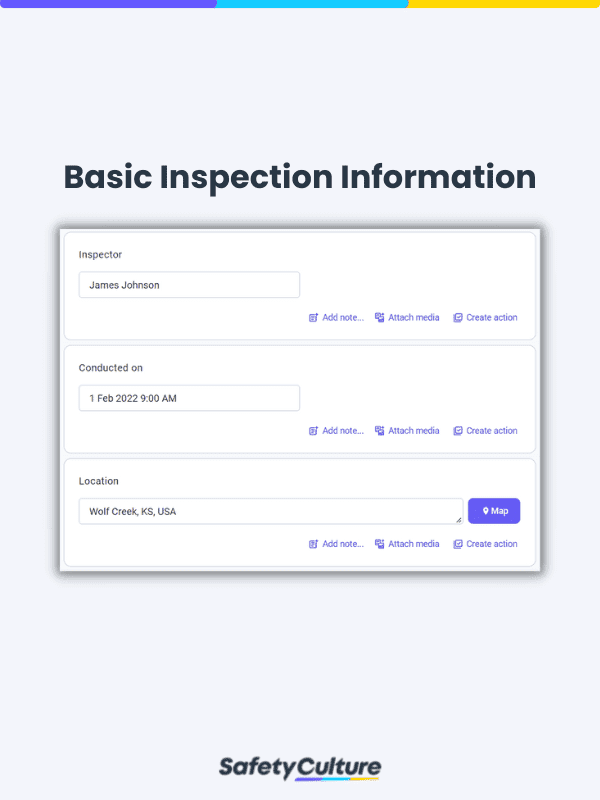
EHS Basic Inspection Information
Step 2: General Facility Inspection
This would list down all items for inspection not directly under the umbrella of environmental, health, and safety. This generally consists of the following items:
- Aisles/exits/egress
- Gas cylinders
- Emergency, health, and safety information
- Fire emergency
- Fire prevention
- Flammables/combustibles
- Housekeeping/work environment
- Security items
- Structures
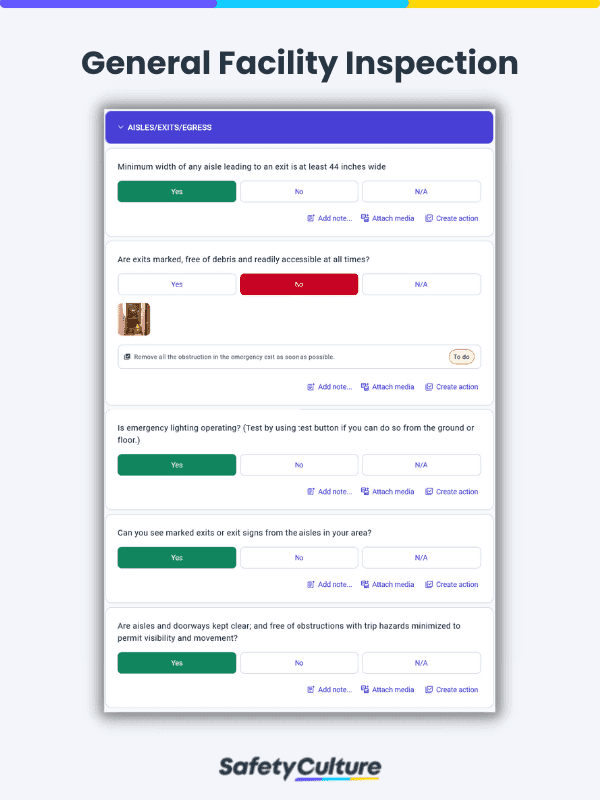
EHS Compliance General Facility Inspection
Step 3: Environmental Inspection
This part includes review of items to ensure that any organization activities won’t result in unnecessary environmental harm. This generally consists of the following items:
- Clean air act compliance
- Clean water act compliance
- Hazardous/non-hazardous waste compliance
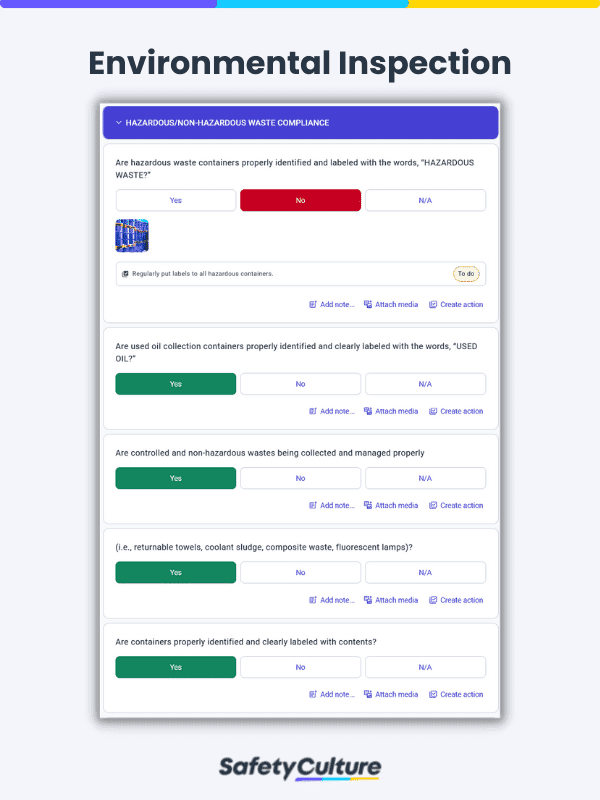
EHS Compliance Environmental Inspection
Step 4: Safety/Health Inspection
This part covers the safety and health components directly involving the facility and the people occupying it. This generally consists of the following items:
- Employee work practices
- Electrical equipment markings
- Equipment
- Ergonomics
- Eyewash station
- Forklift/industrial trucks
- Hazard communication
- Hoist/cranes/lifting devices
- Ladders/scaffolding
- Personal protection equipment (PPE): eye and face/respiratory/hearing
- PPE: all protection
- Walking surfaces/stairs
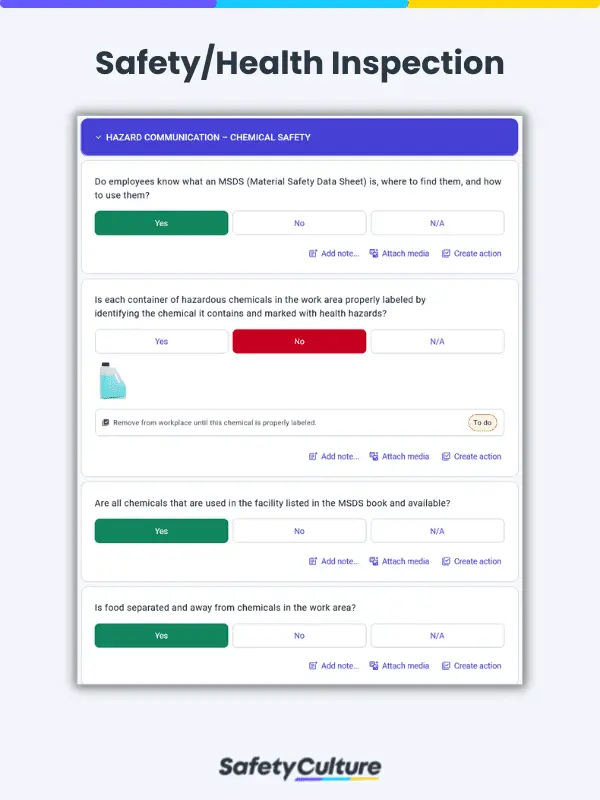
EHS Compliance Safety and Health Inspection
Step 5: Assessment
Detail your general assessment of the EHS inspection, and include any recommendations you may have. Don’t forget to add important signatures needed to complete the inspection.
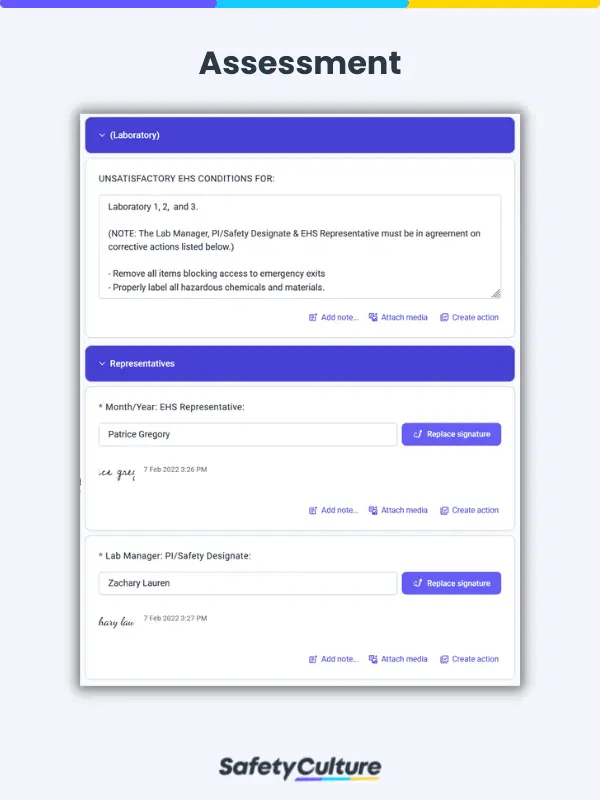
EHS Compliance Assessment
SafetyCulture for EHS Compliance Inspections
EHS Inspections should be done regularly and must easily be updated in accordance with changes in rules and policies. EHS assessments should also be well documented and accessible anytime. SafetyCulture (formerly iAuditor), is web-based and mobile app that businesses can use in daily operation inspections in compliance with EHS regulations and in using and creating EHS audit checklists. This software can also offer the following features:
- Take and include photo attachments to make your inspections faster and more visible
- Create recommendations and instructions using SafetyCulture’s Actions feature, and immediately assign them to personnel for time-sensitive response
- Offers ready-to-use EHS Templates, or create and customize them according to your business needs
- Utilize paperless inspections for EHS assessment and cloud-based recordkeeping
- Train employees on proper EHS compliance and practices
- Monitor assets and ensure they are safe for use and compliant with safety standards
- Generate EHS Compliance reports, anytime and anywhere

